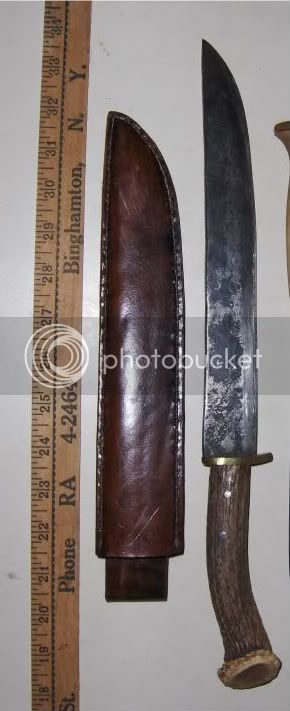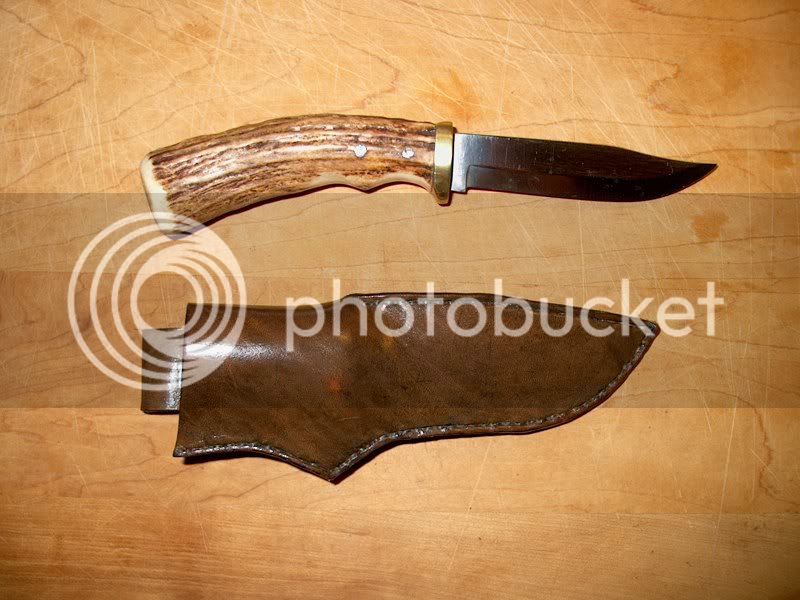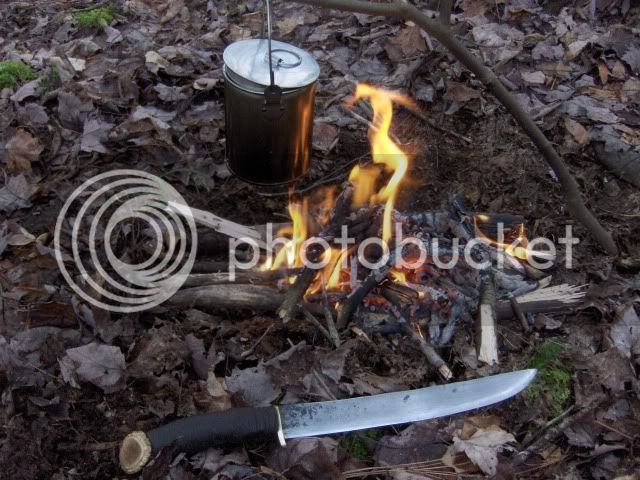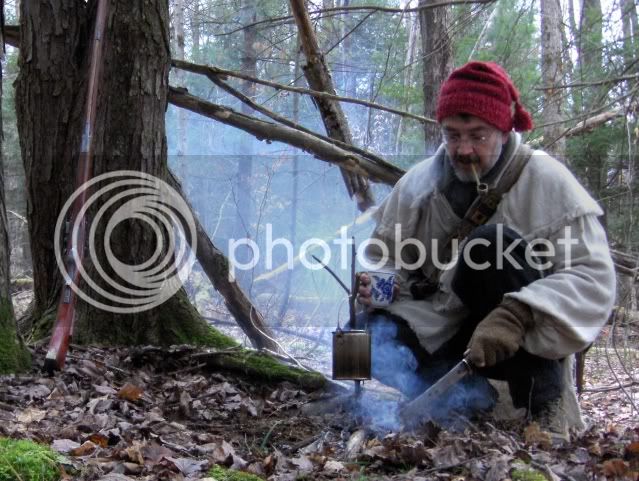Let me add that on other projects glue may have a place. Elmer's Glue is not water proof and neither is hide glue. In some work with small pieces you can glue the part (this would usually be a metal part)to a larger surface- do what you need to do and then soak the works to dissolve the glue and release the tiny part. Heat can also be used on other glues to free a part being worked upon.
You are using an out of date browser. It may not display this or other websites correctly.
You should upgrade or use an alternative browser.
You should upgrade or use an alternative browser.
Why Use Glue?
- Thread starter SpottedBull
- Start date

Help Support Muzzleloading Forum:
This site may earn a commission from merchant affiliate
links, including eBay, Amazon, and others.
I don't, but usually that's because I don't use rubber cement often enough to keep it from setting up. One reason is to control alignment and prevent puckering where it's not wanted. I usually pre-hole and then put temporary knots every three inches for the same effect.
When I'm adding a thin gusset - then I go to the trouble of gluing to keep my sanity.
When I want a shiny leather surface - or to harden an edge for burnishing - I dilute Aileen's Tacky Glue by half with water and wipe it on. Once dry it buffs up nicely. (Obviously not on splits or the rough side).
These sheaths are done with it.


Both have been soaked in the rain repeatedly over the years and an occasional paste wax buff keeps them hard and slick.
When I'm adding a thin gusset - then I go to the trouble of gluing to keep my sanity.
When I want a shiny leather surface - or to harden an edge for burnishing - I dilute Aileen's Tacky Glue by half with water and wipe it on. Once dry it buffs up nicely. (Obviously not on splits or the rough side).
These sheaths are done with it.


Both have been soaked in the rain repeatedly over the years and an occasional paste wax buff keeps them hard and slick.
Curious - How many use a clam ka stitching pony aka stitching horse?
I know Capt Jas uses a clam but of the others here I'm curious since it is ones "third hand" and when used properly on most things (especially items like holsters and sheaths and yes even pouches) there is no need to baste or otherwise hold it together since the clam does it for you.........
I know Capt Jas uses a clam but of the others here I'm curious since it is ones "third hand" and when used properly on most things (especially items like holsters and sheaths and yes even pouches) there is no need to baste or otherwise hold it together since the clam does it for you.........
Capt. Jas.
58 Cal.
- Joined
- Aug 19, 2005
- Messages
- 3,059
- Reaction score
- 1,373
I am curious as well what everyone uses to hold their work to properly stitch. When I first got into leather many moons ago, I just used pinch clips to hold the pieces together bit nothing to hold my work. I learned a lot from an English trained harness/ saddler friend in the early nineties.
I use the clam almost always in conjunction with hand shoe tacks, removing the tacks as I get to them.
I use the clam almost always in conjunction with hand shoe tacks, removing the tacks as I get to them.
SpottedBull
40 Cal.
- Joined
- Dec 22, 2010
- Messages
- 275
- Reaction score
- 14
I have never used a clam or pony but that is because I don't presently have one. It would probably make some of the work easier and take a lot of the strain off of my elbows. The only time I really hold anything down and together is when I am punching holes in front or back pieces or flaps and want the holes to line up correctly. I usually just punch a few holes in strategic places and push a needle into the hard foam board I use when punching...then punch all the holes. The leather doesn't slide around then. I've used glue about 4 times, when making sheaths and putting a welt between the top and bottom pieces of leather. But thats about all.
I have an old clam and really should learn to use it. That chapter in Book of Buckskinning No. VI by Steven Lalioff shows its correct use. He is a very fine artisan.
Stumpy: sure admire that long knife!
Stumpy: sure admire that long knife!
- Joined
- Aug 25, 2003
- Messages
- 6,534
- Reaction score
- 1,512
IMO, there is no right or wrong here. I use glue on any leather I am going to sew. It makes a cleaner job, it makes it easier. If you want to waste time basting, or whatever, then do it without glue. But, if you can see the glue when finished, then you're just too sloppy with it.
Capt. Jas.
58 Cal.
- Joined
- Aug 19, 2005
- Messages
- 3,059
- Reaction score
- 1,373
For those who may be interested, LaBonte is Chuck Burrows of Wild Rose. He has some great instructional dvds on holster and knife sheath making. I assume his website is listed in the vendor's portion of this site or at least in his profile.
IIRC, his website at one time used to also have some good gratis information on the basics of sewing leather.
IIRC, his website at one time used to also have some good gratis information on the basics of sewing leather.
SpottedBull
40 Cal.
- Joined
- Dec 22, 2010
- Messages
- 275
- Reaction score
- 14
Capt. Jas. said:For those who may be interested, LaBonte is Chuck Burrows of Wild Rose. He has some great instructional dvds on holster and knife sheath making. I assume his website is listed in the vendor's portion of this site or at least in his profile.
IIRC, his website at one time used to also have some good gratis information on the basics of sewing leather.
And his site is also a place for some REALLLLLLLLY serious eye candy. I love looking at his work and hoping one day to produce items evenly slightly close to his stuff.
:bow: :bow: :bow:
Guest
Oh yes! :thumbsup:Spotted Bull said:And his site is also a place for some REALLLLLLLLY serious eye candy. I love looking at his work and hoping one day to produce items evenly slightly close to his stuff.
:bow: :bow: :bow:
Last I checked, they were sold out of DVD's but I managed to find a used set on Amazon for less than fifty bucks. Real recent-like, in the last month or so.
BillinOregon said:Stumpy: sure admire that long knife!
Thanky. That's 'Ol Ugly. Dixie Gun Works used to sell the blank as the "Ft. Ticonderoga". The original was dug at Ft. Ticonderoga and they made a clone of it out of file steel (as I remember). Over the years it has been a work in process. Latest is a tarred jute marline wrapped antler crown (better grip as the original was kind of piddley with cold hands) and I draw filed (drew filed?) the sides much smoother and to a flat taper. It will shave hair off my arm and swipe a 1" green branch off a tree with one chop.
Carries better than a hatchet. Has cleared dozens of ground blinds and fed many fires. The 1/4" spine has also given the coup de grâce to many rabbits and squirrels.


Here's instructions on how-to make a good yet inexpensive pony...once you learn to use one you'll wonder why didn't use one before... http://www.wrtcleather.com/1-ckd/tutorials/_stitchpony.htmlSpotted Bull said:I have never used a clam or pony but that is because I don't presently have one. It would probably make some of the work easier and take a lot of the strain off of my elbows. The only time I really hold anything down and together is when I am punching holes in front or back pieces or flaps and want the holes to line up correctly. I usually just punch a few holes in strategic places and push a needle into the hard foam board I use when punching...then punch all the holes. The leather doesn't slide around then. I've used glue about 4 times, when making sheaths and putting a welt between the top and bottom pieces of leather. But thats about all.
a couple of how-tos on sewing:
How-to do the baseball stitch - this stitch is used to sew two piece of leather edge to edge and it is a period stitch especially handy for sewing a rawhode wrap on an object such as horn or knife handle repair. http://www.wrtcleather.com/1-ckd/tutorials/_baseball.html
The saddke stitch how-to with some variations on the traditional method that I had to develop due to health issues - many folks find it a bit easier to use this method http://www.wrtcleather.com/1-ckd/tutorials/_leatherstitch.html
One change to this - I note you can get linen thread from a source no longer in business - I get most/all my sewing needs, including thread, needles, awls, etc from Campbell-Bosworth
5 cord left or right hand twist is a good all purpose thread for heavier gear such as sheaths and holster. On the other hand 4 cord is good for both and especially if you use a higher stitch per inch such as 8 or more to the inch which is more typical of fine period work.
Campbell- Bosworth: http://campbell-bosworth.com/catalog/advanced_search_result.php?keywords=linen - I have not used the less expensive Hungarian thread myself so cannot offer an opinion whereas I have used the Barbour's for close to 50 years..The Barbour's may sound expensive up front but overall the cost is MUCH cheaper than buying the small rolls from other sources.
Last edited by a moderator:
If the mods think the following is inappropriate please delete.CraigC said:Last I checked, they were sold out of DVD's but I managed to find a used set on Amazon for less than fifty bucks. Real recent-like, in the last month or so.
To clear up any possible mis-conception - the DVD's are still available directly from the publisher.
I have not re-stocked due to a bunch of things going on in my life that have had to take precedence and just haven't had time to deal with re-stocking.
A little story re: using glue
I started doing leather craft 51 years ago. A long the wya I was lucky to have several mentors and also "apprenticed" myself in order to learn as uch as possible - I've over the years made everything from coin purses to tactical gear to saddles with period gear being my real "passion".
One of the masters I apprenticed to was an old German harness/saddle maker who emigrated to the States after WW 1 because he wanted to be a cowboy. He soon found out that real cowboying is not romantic at all and would up in Hollywood working for a while in the movies yet also working at his craft. He later went to work for Ed Bohlin. a Swedish immigrant and also leather crafter who became famous for his Hollywood and parade gear.
Anyway one day he showed me how to properly splice a piece of harness strap together by skiving(tapering) both pieces and then gluing them together. Once glued up a let set for 24 hours he demonstrated how strong that glued joint by putting one end in the vice and tugging hard on the free end - at 6' and around 220 pounds he put a lot of weight behind that tug.
He then looked at me and asked if I thought the piece was done, to which I replied I reckon so. He smiled and then went over to the stitcher and ran a couple of lines of stitching along each eadge of the splice. Now it's done he said and the reason is without the stitching most folks wouldn't consider it done or strong enough even though it was plenty strong.
The moral is that it is often perception and not the facts that count....
I started doing leather craft 51 years ago. A long the wya I was lucky to have several mentors and also "apprenticed" myself in order to learn as uch as possible - I've over the years made everything from coin purses to tactical gear to saddles with period gear being my real "passion".
One of the masters I apprenticed to was an old German harness/saddle maker who emigrated to the States after WW 1 because he wanted to be a cowboy. He soon found out that real cowboying is not romantic at all and would up in Hollywood working for a while in the movies yet also working at his craft. He later went to work for Ed Bohlin. a Swedish immigrant and also leather crafter who became famous for his Hollywood and parade gear.
Anyway one day he showed me how to properly splice a piece of harness strap together by skiving(tapering) both pieces and then gluing them together. Once glued up a let set for 24 hours he demonstrated how strong that glued joint by putting one end in the vice and tugging hard on the free end - at 6' and around 220 pounds he put a lot of weight behind that tug.
He then looked at me and asked if I thought the piece was done, to which I replied I reckon so. He smiled and then went over to the stitcher and ran a couple of lines of stitching along each eadge of the splice. Now it's done he said and the reason is without the stitching most folks wouldn't consider it done or strong enough even though it was plenty strong.
The moral is that it is often perception and not the facts that count....
I have to agree with Wick - IMO the only caveat being that when doing period pieces one should also be able to do it in a period method and with only period materials on demand or be honest about your methods/materials.Wick Ellerbe said:IMO, there is no right or wrong here. I use glue on any leather I am going to sew. It makes a cleaner job, it makes it easier. If you want to waste time basting, or whatever, then do it without glue. But, if you can see the glue when finished, then you're just too sloppy with it.
While I do glue some of my period pieces (mostly on holsters and sheaths) it all depends on the end user - many folks only care about the final look and not the methods/materials, while others want it done using methods and material as close as possible to the originals - of course one can also charge more for the latter since it often takes more time/effort.
The bottomline is be honest with the end user about what you can use/do and when doing perod pieces what is PC and what is not - with each and every end user I discuss the differences so they get to choose.
Bull - thank you and I hope it inspires others. But also anyone can do what I do - it's just a matter of wanting too, finding your particular muse, and then practice, practice, practice. Even after 51 years I don't consider myself a master and when I haven't done a certain type of work I practice a bit before starting a project, because while the knolwdge is still there the actual work needs a bit of a start.Spotted Bull said:And his site is also a place for some REALLLLLLLLY serious eye candy. I love looking at his work and hoping one day to produce items evenly slightly close to his stuff.Capt. Jas. said:For those who may be interested, LaBonte is Chuck Burrows of Wild Rose. He has some great instructional dvds on holster and knife sheath making. I assume his website is listed in the vendor's portion of this site or at least in his profile.
IIRC, his website at one time used to also have some good gratis information on the basics of sewing leather.
:bow: :bow: :bow:
One other thing - Several years ago I faced burn out big time, but then I quit worrying/stressing over being perfect and my work not only became enjoyable again, but got better, especially when I quit trying to rush things.
As for "mistakes" - a good friend gave me some good advice years ago - If you can't fix it feature it. and I have found often times he was right! On the other hand don't be afraid to start over - my scrap box is full of stuff that just didn't work out )the same is true for every pro I know) and trying to fix it just made it worse or even worse it was a waste of time and energy...
- Joined
- Aug 25, 2003
- Messages
- 6,534
- Reaction score
- 1,512
I would pretty much agree with that.LaBonte said:I have to agree with Wick - IMO the only caveat being that when doing period pieces one should also be able to do it in a period method and with only period materials on demand or be honest about your methods/materials.Wick Ellerbe said:IMO, there is no right or wrong here. I use glue on any leather I am going to sew. It makes a cleaner job, it makes it easier. If you want to waste time basting, or whatever, then do it without glue. But, if you can see the glue when finished, then you're just too sloppy with it.
While I do glue some of my period pieces (mostly on holsters and sheaths) it all depends on the end user - many folks only care about the final look and not the methods/materials, while others want it done using methods and material as close as possible to the originals - of course one can also charge more for the latter since it often takes more time/effort.
The bottomline is be honest with the end user about what you can use/do and when doing perod pieces what is PC and what is not - with each and every end user I discuss the differences so they get to choose.
Capt. Jas.
58 Cal.
- Joined
- Aug 19, 2005
- Messages
- 3,059
- Reaction score
- 1,373
LaBonte said:I have to agree with Wick - IMO the only caveat being that when doing period pieces one should also be able to do it in a period method and with only period materials on demand or be honest about your methods/materials.
While I do glue some of my period pieces (mostly on holsters and sheaths) it all depends on the end user - many folks only care about the final look and not the methods/materials, while others want it done using methods and material as close as possible to the originals - of course one can also charge more for the latter since it often takes more time/effort.
The bottomline is be honest with the end user about what you can use/do and when doing perod pieces what is PC and what is not - with each and every end user I discuss the differences so they get to choose.
Agreed! Well Said!
Capt. Jas.
58 Cal.
- Joined
- Aug 19, 2005
- Messages
- 3,059
- Reaction score
- 1,373
LaBonte said:Even after 51 years I don't consider myself a master and when I haven't done a certain type of work I practice a bit before starting a project, because while the knolwdge is still there the actual work needs a bit of a start.
One other thing - Several years ago I faced burn out big time, but then I quit worrying/stressing over being perfect and my work not only became enjoyable again, but got better, especially when I quit trying to rush things.
As for "mistakes" - a good friend gave me some good advice years ago - If you can't fix it feature it. and I have found often times he was right! On the other hand don't be afraid to start over - my scrap box is full of stuff that just didn't work out )the same is true for every pro I know) and trying to fix it just made it worse or even worse it was a waste of time and energy...
Worth being a sticky on the craftsman page!
This thread is turning to gold. Agree it is approaching sticky status!
Similar threads
- Replies
- 10
- Views
- 876
- Replies
- 1
- Views
- 213




